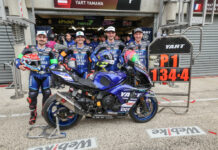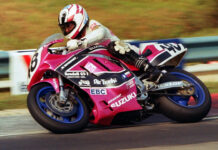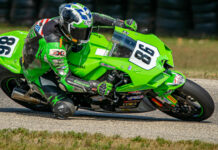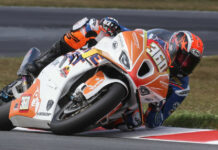From a press release:
MICHELIN GEARS UP FOR MotoGP HORSEPOWER RACE
Michelin are gearing up for their most challenging Grand Prix season in years.
The French tire giant, which has dominated both the 500cc and Superbike World Championships since the early 1990s, faces a new challenge with the new-look MotoGP World Championship. For the first time in GP history 990cc four-strokes will contest bike racing’s premier series, and these machines are by far the most powerful motorcycles ever seen on a racetrack.
Since last year Michelin has been working closely with Honda and Yamaha, the two factories at the vanguard of the four-stroke MotoGP revolution, developing tyres for this new breed of racing machine. With horsepower outputs already well up on the 500cc two-strokes, Michelin engineers have had to create a new generation of rear tire capable of handling in excess of 200 horsepower.
“This is an exciting and very busy time for us,” says Michelin’s motorcycle competitions chief Nicolas Goubert. “And we’re trying to look as far ahead as possible because we know the factories can get much more power from their engines. As soon as the racing starts in April, and one rider sees another in front, they’ll want more horsepower. I think it will be easy for the factories to get 240 or 250 horsepower; power is not a problem. And it is our job to make tires which allow riders to get the best out of these incredible machines. We are mainly using our experience from 500 GPs to create these tires, though our knowledge from World Superbike has also helped because the bikes are four-strokes and heavier than 500s, like the MotoGP bikes.”
Since serious four-stroke testing began last summer, Michelin has been working to produce a new variant of their hugely successful 16.5-inch rear slick, specifically suited to the more powerful and heavier four-strokes. So far they have produced three different profiles and multiple different compounds/constructions, with a fourth profile due at the IRTA team tests at Catalunya, Spain, on March 9/10, the first occasion all the major teams will share the same racetrack. A 16-inch slick has also been evaluated during Michelin’s MotoGP development program.
“Our four-stroke tire takes the 16.5-inch concept further down the same road of development,” explains Goubert. “We started development using the same 16.5 rim size but the four-stroke tire has a larger center diameter, giving a different profile to increase the contact patch and thus reduce running temperature. The new profile also offers improved edge grip, because the four-strokes have more torque available when the riders start to open the throttle at full lean, and more traction, because you need a lot of acceleration grip if you’ve got 240 or 250 horsepower. In some ways the tire is very different from our 500 tires, though the compound and construction are quite similar.
“That was our starting point and it was a big improvement, working pretty well straight away. Also, we found out quite quickly that the four-strokes aren’t as demanding on tires as we thought they’d be. Since then we’ve tried many other things, even a 16-inch rim with a wider tire to take another step but that didn’t give us what we were looking for. Obviously every time we try something new there’s an objective but sometimes the results aren’t what we expected; that’s what testing and development are all about. So we’ve stayed fairly true to our initial four-stroke design because it works so well, but of course we are still working. We will have another rear profile for our riders to test in March and, to be honest, we think the rear may change more in the future than it has so far.
“We’ve also done race-distance endurance testing with both Yamaha and Honda and it seems that there’s not a huge difference between the demands of the 500s and the four-strokes over race distance. But, as I said, this is early days for the four-strokes, what happens from now on may be a very different story, so we’ve got to keep working.”
Like any aspect of racing, whether it be engine, chassis or tire design, development moves ahead in a spiral. When engineers improve one aspect of a machine, another facet will inevitably need to be improved to restore overall balance. This is especially true in tire design: improve the rear tire and the rider will be able to get on the throttle earlier in the corner and at a greater angle of lean. This transfers more weight to the rear of the bike, taking weight and therefore grip and steering capability, away from the front, which must then be restored by adjusting chassis and suspension balance.
“Whether it’s the front or the rear, every time you gain something at one end, you have to make a similar step forward at the other end,” adds Goubert. “So when we build a grippier rear tire that sustains more cornering force, it’s going to make the front push when the rider gets on the throttle. In this case we do look to the chassis and suspension guys to help by adapting their settings. In fact we already improved our front slick by quite a lot at the end of last season. We brought a different construction front to the Rio GP and the few guys who had the chance to properly test the tire jumped on it. We then asked all our riders to try the tire during the winter and 90 percent liked it. So far we’ve not been asked by any of our four-stroke riders to concentrate on improving the front because that tire was a good step forward and it seems to work well with the new bikes. But we have been doing some extra front-tire testing with the Gauloises Yamaha Tech 3 team and what we’re learning with them might help us to improve our front tire still further.”
Racetrack development also throws up unexpected results from time to time, and Michelin’s engineers were surprised and pleased to discover that the larger-profile 16.5 also works well with the 500s. “Most of the 500 riders who’ve tried the tire really like it, though some say it pushes the front too much,” Goubert continues. “Every time we go to a new track we’ll see how the tire works with the 500s, because it’s sure to work better at some circuits and not so well at others.”
Unlike last year Michelin won’t be supplying tires to every team on the MotoGP grid during 2002. Two rival tire manufacturers have joined the series and Michelin are delighted to have some competition again, though most riders and teams are still choosing Michelin tires, which have won every 500 title since 1992 and every World Superbike title since 1994. The company will continue its policy of making the same tires available to all of its riders whenever possible, though the diversity of machinery entered in the 2002 series from Honda’s RCV V5 four-stroke to Yamaha’s YZR-M1 inline four-cylinder four-stroke and a number of “old-school” 500 V4 two-strokes requires that Michelin may have to undertake specific development work with different teams.
“If one of the new bikes turns out to have very different demands from the others, then we’ll create tires for that bike, and then make those tires available to anyone else who wants them,” explains Goubert. “As always, the policy is to give the same priority to all our partners.”
MICHELIN’S 2002 MotoGP PARTNERS
MotoGP–500cc(2-stroke)/990cc(4-stroke)
Malboro Yamaha Team (4-stroke)
Max Biaggi
Carlos Checa
West Honda Pons (2-stroke)
Loris Capirossi
Alex Barros
Repsol-YPF Yamaha d’Antin (2-stroke)
Pere Riba
Norick Abe
Honda Pramac Racing (2-stroke)
Tetsuya Harada
HRC
Valentino Rossi
Tohru Ukawa
Gauloises Yamaha Tech 3
Olivier Jacque
Shinya Nakano
Fortuna Honda Gresini
Daijiro Katoh
RECENT MICHELIN WORLD CHAMPIONSHIP VICTORIES
500cc GRAND PRIX
1992, Wayne Rainey (Marlboro Team Roberts Yamaha-Michelin)
1993, Kevin Schwantz (Lucky Strike Suzuki-Michelin)
1994, Mick Doohan (Repsol Honda-Michelin)
1995, Mick Doohan (Repsol Honda-Michelin)
1996, Mick Doohan (Repsol Honda-Michelin)
1997, Mick Doohan (Repsol Honda-Michelin)
1998, Mick Doohan (Repsol Honda-Michelin)
1999, Alex Crivill? (Repsol YPF Honda-Michelin)
2000, Kenny Roberts (Telefonica Movistar Suzuki-Michelin)
2001, Valentino Rossi (Nastro Azzurro Honda-Michelin)
WORLD SUPERBIKE
1994, Carl Fogarty (Ducati-Michelin)
1996, Troy Corser (Ducati-Michelin)
1997, John Kocinski (Castrol Honda-Michelin)
1998, Carl Fogarty (Ducati Performance-Michelin)
1999, Carl Fogarty (Ducati Performance-Michelin)
2000, Colin Edwards (Castrol Honda-Michelin)
2001, Troy Bayliss (Ducati Infostrada-Michelin)
Michelin’s Take On MotoGP Championship
Michelin’s Take On MotoGP Championship
© 2002, Roadracing World Publishing, Inc.






